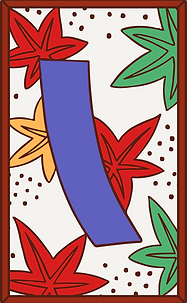Create Your First Project
Start adding your projects to your portfolio. Click on "Manage Projects" to get started
final portfolio
Date
December 24
Project type
Photoshop and Design
Hwatu, a traditional Korean card game, traces its origins to the Japanese hanafuda deck, sharing much of its visual language but replacing Japanese text and iconography with Korean elements. For this project, I selected four cards from the original hanafuda deck that prominently feature Japanese symbols and reimagined their designs. Through this work, I aim to challenge and destabilize the narratives surrounding colonization and annexation, offering a more nuanced perspective on the legacy of Japanese occupation in Korea.

.png)

The first card I redesigned is from the first suit, January. As red cranes and pine trees are heavily imbued in both Japanese and Korean culture, I decided to keep both images. Instead, I chose images from Joseon dynasty painters and overlaid images on top of each other to create a dynamic background. By removing the image of the red sun, I wanted to challenge how often we see images of colonization and violence in every day iconography. The red circle at the right bottom corner of the card identifies the card as one of the bright cards in the deck.
January (송학 - Pine Crane) Suit
Bright (광) card
left: Hanafuda deck designed by Louie Mantia
right: Korean hwatu deck



February (매화 - Plum Blossom) Suit
Ribbon (띠) card
left: Hanafuda deck designed by Louie Mantia
right: Korean hwatu deck
The second card I redesigned is from the second suit, February. Plum blossoms are an important symbol in Korean culture, as they represent renewal, hope, and perseverance. I saw it fitting to keep a plum blossom due to its meaning with the added understanding of how these flowers further represent the perseverance of Korean identity during Japanese occupation. In the original hanafuda deck, the poetry ribbon cards are adorned with Japanese calligraphy. Now, the Korean hwatu deck has Korean hangul writing on the ribbons that say 홍단, "red ribbon." I wanted to continue the matter of overlaying different Korean paintings as the background and for the ribbon itself chose a watercolor design, as watercolor and ink paintings had much significance in Korean culture.
Similar to the plum blossom card, this blue ribbon card from the October suit features Korean calligraphy. Here, the ribbon says 청단 which means blue ribbon. The blue poetry ribbons in the hanafuda deck also have a deeper, more purple hue to them compared to the hwatu deck. Some ribbons in the hanafuda deck do not have writing on them. The October suit in both the hanafuda and hwatu deck are represented through maple leaves. For this particular card, I decided to add ginkgo leaves as well as the original maple leavesthat are present. In Korea, golden ginkgo leaves signify the change in seasons to autumn and are seen throughout the country. The trees were introduced to Korea through Confucian teaching and remain an important part of the culture in representing longevity, wisdom, and resilence.
* 비 in Korean means rain, which the suit is also known as, but the English name of the suit is willow.
While its unclear when the hwatu deck adopted willow/rain for the December suit compared to the November in the hanfuda deck, the bright card in this suit features a commoner wearing a beonggeoji (a Korean round hat), instead of the image of Ono no Michikaze on the Rainman hanafuda card in his Kanmuri (a Heian-period Japanese cap). Associations with the Japanese calligrapher were removed. In this recreation of the card, I decided to overlay an image of Sin Suk Ju, a Korean Joseon dynasty politician. His loyalty to the king rewarded him with an official portrait by the royal court. I continued to use Korean symbols such as a Joseon dynasty sytle umbrella and an image of a beonggeoji on the top most layer.


October (단풍 - Maple Leaves) Suit
Ribbon (띠) card
left: Hanafuda deck designed by Louie Mantia
right: Korean hwatu deck


December (비* - Willow) Suit
Bright (광) card
left: Hanafuda deck designed by Louie Mantia
right: Korean hwatu deck



















